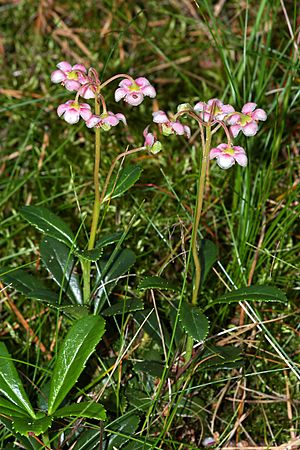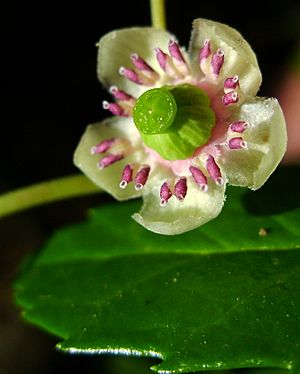Umbellate wintergreen facts for kids
Quick facts for kids Umbellate wintergreen |
|
|---|---|
 |
|
| Conservation status | |
| Scientific classification | |
| Genus: |
Chimaphila
|
| Species: |
umbellata
|
Chimaphila umbellata, also known as the umbellate wintergreen, pipsissewa, or prince's pine, is a small plant that blooms every year. You can find it growing in dry woodlands or sandy soil. This plant is native to many cool parts of the Northern Hemisphere.
It usually grows to be about 10 to 35 centimeters (4 to 14 inches) tall. Its leaves are shiny and bright green, staying green all year long. They have small teeth along their edges, and these teeth have tiny hairs. The leaves grow in pairs or in groups of 3 or 4 along the stem. The plant's flowers are white or pink and grow in a small cluster of 4 to 8 flowers together.
Contents
How Pipsissewa Gets Food
Even though pipsissewa has green leaves all year, it gets a lot of its food from tiny fungi in the soil. This means it's a "partial myco-heterotroph." It's like the plant works with the fungi to get the nutrients it needs. Other plants related to pipsissewa, like the Pyrola plant, also get some or all of their food this way.
Different Kinds of Pipsissewa
There are four main types, or subspecies, of Chimaphila umbellata:
- Chimaphila umbellata subsp. umbellata – Found in Europe and Asia.
- Chimaphila umbellata subsp. acuta – Grows in the southwestern parts of North America.
- Chimaphila umbellata subsp. cisatlantica – Found in the northeastern parts of North America.
- Chimaphila umbellata subsp. occidentalis – Grows in the northwestern parts of North America.
What Pipsissewa Is Used For
Some Native American tribes in the Northwest Plateau region used a special tea made from prince's pine. They used it to help treat a lung sickness called tuberculosis.
A traditional healer from the 1900s, Clarence "Catfish" Gray, believed pipsissewa helped his own heart problems. He even included it in his special mix of 15 herbs.
Today, pipsissewa is used to add flavor to candies and soft drinks, especially root beer. You can also boil the roots and leaves of Chimaphila umbellata to make a tea.
The Meaning of "Pipsissewa"
The name "Pipsissewa" comes from the Cree language. It means "It-breaks-into-small-pieces."




